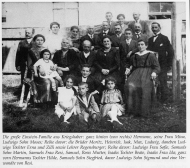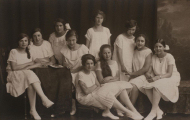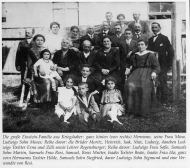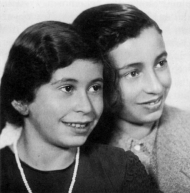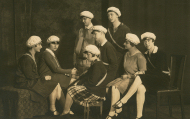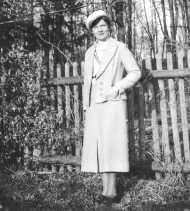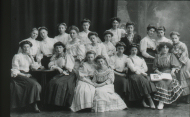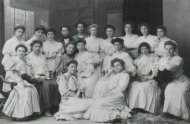|
|
|
|
|
|
|
|
|
|
|
|
|
|
|
|
|
|
|
|
|
|
|
|
|
|
|
|
|
|
|
|
|
|
|
|
|
|
|
|
|
|
|
|
|
|
|
|
|
|
|
|
|
|
|
|
|
|
|
|
|
|
|
|
|
|
|
|
|
|
|
|
|
|
|
|
|
|
|
|
|
|
|
|
|
|
|
|
|
|||||||||||||||||||||||||||||||||||||||||||||||||||||||||||||||||||||||||||||||||||||||||||||||||
|
|
Eva Eckert Born: 1927 in Munich. Father’s occupation: General Practitioner. Eva’s father, Dr. Heinz Eckert (b. 1892 in Rheydt), was a Protestant; he died in 1926, four months before Eva was born. Her mother was Elisabeth, “Else”, née Kahn (b. 1898 in Augsburg). Eva had a brother, Wolfgang (“Wolf”, b. 1922). An older cousin of Eva was Ruth Kahn. Eva was baptized a Protestant. She joined the class 1a of Maria-Theresia-School in the school year 1937/38. During the war, her mother worked, initially voluntarily, in an armaments factory, which provided her protection from deportation for some time (July 1942 – January 1944). In December 1943, Eva had to leave school as a “first class half-breed” by order of the Reich Ministry. Eva’s mother was deported to Terezin in January 1944, where she lived until her liberation in Spring 1945. Wolf and Eva stayed in the family apartment in Augsburg. As a “half-breed” Wolf had had to leave the school of engineering. In 1944 he was taken to a camp in Jena to do forced labor. After the war, Eva initially attended Maria-Theresia-School again. One of her teachers, Dr. Georg Keßler, gave her private Latin lessons. In January 1947, Eva’s brother, Wolf, died in Augsburg. In 1948, Eva and her mother, Else, emigrated to New York. Eva attended Hunter College at night and got her Master’s Degree from Columbia University. She was a bilingual secretary while she went to school, and later a science and medical librarian. In order to take care of her mother, who was diagnosed with Parkinson’s, Eva did not write a dissertation. Her care of her mother lasted 17 years. |
Up to this day, Eva Eckert is still living in the USA (April 2007). (Eva Eckert gave us much information for this biography via her relative Joyce Meltz.) Sources and further reading: Wolfgang Graf, “Direktor Sohr und der ‘jüdische Mischling’,” 100 Jahre Maria-Theresia-Gymnasium. Festschrift zur 100-Jahr-Feier des Maria-Theresia-Gymnasiums, Augsburg, 1992, pp. 60–61. Peter Wolf, ed., Spuren. Die jüdischen Schülerinnen und die Zeit des Nationalsozialismus an der Maria-Theresia-Schule Augsburg. Ein Bericht der Projektgruppe “Spurensuche” des Maria-Theresia-Gymnasiums, Augsburg, 2005, pp. 105–6. |
Rosa Eigner Born: c. 1906. Father’s occupation: businessman (neither Rosa’s place of birth nor the occupation of her father is given in the Annual School Report of 1916/17). Rosa’s parents were Adolph Eigner (b. 1876 in Lopasov, Austria-Hungary) and Katharina Lentner. Adolph was Jewish, Katharina presumably was non-Jewish. Adolph ran a furniture shop. Rosa attended Maria-Theresia-School in 1916/17 in class 1a and perhaps also in the following year, 1917/18. Many Jews who were married to Christians were deported from Augsburg to Terezin only late, in January 1944. Among them was Rosa’s father, Adolph. When the camp was liberated in the spring of 1945, he returned to Augsburg. In 1947 or 1948, Adolph Eigner was elected vice chairman of the Jewish community of Swabia-Neuburg. He died in Augsburg in 1952. |
|
|
Beate Einstein Born: 1916 in Augsburg. Father’s occupation: businessman. Private residence: 185 Ulmer Straße. Company: 139 Ulmer Straße. Beate’s father, Isaak Einstein (b. 1884 in Kriegshaber), was one of six partners who owned one of the leading Swabian livestock dealing companies (“Einstein Brothers”). The company was located in Kriegshaber (since 1916 one of Augsburg’s districts). The other partners were Isaak’s brothers Samuel (b. 1870), Ludwig (b. 1873), Heinrich (b. 1878), Hermann (b. 1880), and Moritz (b. 1886). Isaak’s wife was Ida Einstein, née Schloßberg or Schloßberger (b. 1890 in Unterdeufstetten). Isaak’s family lived on the second floor of the house 185 Ulmer Straße. Three other brothers Einstein lived on the first floor: Heinrich, Moritz, and Max (b. 1876). Max was the only one of the Einstein brothers who was not part of the family company. Beate is a cousin of Brunhilde, Erna, and Liese Einstein. Beate attended Maria-Theresia-School from 1927 to 1933 in classes 1–6. In 1939, Beate emigrated to Great Britain. In 1946, she married Martin Ansbacher (b. 1909 in Leutershausen), whom she had met playing tennis in Augsburg. The name Ansbacher was anglicized to “Anson”. The couple had two children. In Scotland, they founded a textile factory in 1958, which is run by the family in the third generation by now (it was called “Anson of Scotland” at first, then “Abercairn of Scotland”). The factory produces and sells knitwear, e.g., hats, scarfs and gloves. The first label they called “Maban”, using the first letters of the words “Martin And Beate Anson”. Beate’s husband, Martin Anson, died in Glasgow in 2003. Beate Anson, née Einstein, lives to this day in Scotland (2006). |
Beate’s parents were deported to Auschwitz in March 1943 and are listed as missing, as well as Beate’s uncle Hermann Einstein and his wife, Mina, née Schloßberg, and Beate’s uncle Moritz Einstein and his wife, Lydia, née Seligmann. Beate’s uncles Ludwig and Samuel Einstein died in 1936 and 1939, respectively. Beate’s uncle Max Einstein and his wife, Johanna, née Stern (b. 1882), were deported to Piaski, Poland, at the beginning of April 1942 and were declared dead, as well as Beate’s uncle Heinrich Einstein. Beate’s grandmother on her mother’s side, Ernestine Schloßberger, née Neumetzger, was deported to Terezin in Summer 1942 and died there. Beate’s cousin Martin Einstein married Marianne Veith in Palestine in 1935. Aside: Henry Landman (Heinz Landmann) lists Beate’s parents among the many Jews who were deported from Augsburg to Auschwitz in March 1943. According to the Gedenkbuch edited by the “Bundesarchiv” (second edition, 2006), however, Isaak and Ida Einstein were deported to Auschwitz already in 1942. Source: Objects loaned from Beate Anson, to be seen at the Museum of Jewish Culture, Augsburg (2006). |
|
Brunhilde Einstein Born: 1916 in Augsburg. Father’s occupation: livestock dealer. Private residence: 149 Ulmer Straße. Company: 139 Ulmer Straße. Brunhilde’s father, Hermann Einstein (b. 1880 in Kriegshaber), was one of six partners who owned one of the leading Swabian livestock dealing companies (“Einstein Brothers”). The company was located in Kriegshaber (since 1916 one of Augsburg’s districts). The other partners were Hermann’s brothers Samuel (b. 1870), Ludwig (b. 1873), Heinrich (b. 1878), Isaak (b. 1884), and Moritz (b. 1886). Another brother, Max (b. 1876), was the only one who was not part of the family company. Hermann’s wife was Mina, née Schloßberg or Schloßberger (b. 1889 in Unterdeufstetten). Brunhilde (“Hilde”) was a cousin of Beate, Erna, and Liese Einstein. Hilde attended Maria-Theresia-School from 1926 to 1933 in classes 1–6. She had to repeat a year (class 3). For some time, Hilde worked as a nanny in Cologne. Around 1939, Hilde emigrated to England and kept the household of a family in Manchester. In 1940, her cousin Liese Einstein also followed her into this household. Later, Hilde emigrated to New York, where she married Martin Lehman from Rothenburg on Tauber in 1949. Hilde worked as a masseuse at first, then in her husband’s butcher’s shop. Martin died in New York in 1988. Brunhilde Lehman, née Einstein, died in New York in 1994. Brunhilde’s parents were deported to Auschwitz in March 1943 and are listed as missing, as well as Brunhilde’s uncle Isaak Einstein and his wife, Ida, née Schloßberg, and Brunhilde’s uncle Moritz Einstein and his wife, Lydia, née Seligmann. Brunhilde’s uncles Ludwig and Samuel Einstein died in 1936 and 1939, respectively. |
|
|
|
Else Einstein Born: 1910 in Augsburg. Father’s occupation: owner of a brewery and land owner. Address: B 5 / 7 Maximilianstraße. Else’s father was Gustav Einstein (b. 1882 in Buttenwiesen), her mother Richa (Ricka, Rika), née Bissinger (b. 1887 in Ichenhausen). Gustav was the owner of the brewery “Unterbaarer Bier”. Unterbaar is a small town near Augsburg. Else attended Maria-Theresia-School from 1924 to 1926 in classes 5a and 6a; presumably, she began as early as 1920 in class 1. In May 1925, Else celebrated her “confirmation” together with nine other Jewish girls; Ilse Thanhauser was among them. (Bat Mitzvah: The Jewish “coming of age” ritual for girls can be held individually on the Sabbath after the girl’s 12th birthday. In Augsburg, however, it was held—similar to the Protestant confirmation—annually or even after longer intervals for several age groups together.) In 1926, Else graduated from the Maria-Theresia-School. On the final class-photo, however, Else is not to be seen; Ilse Baehr, née Thanhauser, remembers that Else did not want to be photographed and thus did not appear for the session (e-mail from March 1st, 2006). In 1933, Else’s father, Gustav, went on holiday to Switzerland and did not return to Germany. The national socialists launched a malicious campaign against him and charged him with currency smuggling. According to a “tax warrant of apprehension” of the tax office (concerning the “Tax on Capital Flight”), Gustav, whose profession was now described as a trader of goods, emigrated together with her mother, Richa, to Evreux near Paris in 1933. After several intermediate stops, the couple emigrated to the USA. Richa died there in 1953. Gustav returned to Germany in 1956. He went through a long |
restitution process to regain the Renaissance castle Unterbaar, which he had bought in 1928. He died in Unterbaar in 1960; in 1962, Else sold the castle. Else had transferred to Paris in 1933 and worked there as a physical education teacher. In 1940, she was interned at Camp de Gurs, in the Southwest of France, as well as Marie Bach. 2364 women from Paris and its surrounding area arrived at the camp on May 23, 1940, among them many Jews. They were single women—or married women without children—who had the German nationality. That is why they were automatically regarded as suspect, especially with the war between Germany and France beginning to be fought, and therefore interned. Thereafter, about 7,500 Jews from Baden and the Saar-Palatinate were deported to Gurs on October 22, 1940 (among them was Rosa Lieblich). The police of the Vichy regime continued sending to this camp Jews who had been apprehended in France. In 1941, Else succeeded in escaping from the camp. She emigrated to the USA. In New York, she married Charles Zdenko Sajovic. Two children were born to them in 1943 and 1945, respectively. Else worked as a masseuse. In the beginning of the 1970s, Else’s husband died and she returned to Germany. She married a second time; her second husband was David Spivak. Else Spivak, née Einstein, died in Munich in 1999. |
|
|
Erna Einstein Born: 1909 in Kriegshaber (near Augsburg). Father’s occupation: businessman. Company and private residence: 139 Ulmer Straße, Augsburg. Erna’s father, Ludwig Einstein (b. 1873 in Kriegshaber), was one of six partners who owned one of the leading Swabian livestock dealing companies (“Einstein Brothers”). The company was located in Kriegshaber (since 1916 one of Augsburg’s districts). The other partners were Ludwig’s brothers Samuel (b. 1870), Heinrich (b. 1878), Hermann (b. 1880), Isaak (b. 1884), and Moritz (b. 1886). Another brother, Max (b. 1876), was the only one who was not part of the family company. Erna’s mother was Sofie, née Mendle (b. 1877 in Kriegshaber). Erna was a cousin of Beate, Brunhilde, and Liese Einstein. Erna attended Maria-Theresia-School from 1924 to 1926 in classes 4a and 5b. She may have begun in 1921 in class 1. Erna emigrated to Johannesburg, South Africa, in 1934. She was married to Walter Levison (or Levyson, b. 1913 in Berlin), who had worked for the firm “Pflaunlacher & Schwab” in Augsburg. The couple had a daughter. Walter founded a rubber stamp factory. He died in 1943. Erna married a second time. Her second husband was Walter Kuhn (b. 1911 in Berlin). He took over the factory. The couple had a son. Walter died in Johannesburg in 1993. Erna Kuhn, née Einstein, died in Johannesburg in 1973. Erna’s father, Ludwig, died in 1936. The widowed Sofie Einstein emigrated to South Africa just like Erna. She died in Johannesburg in 1962. Three siblings of Erna survived their early childhood: Cäcilia (“Cilly”, b. 1899), Max (b. 1901) and Sigmund (b. 1914). They also emigrated to South Africa. |
|
|
|
Liese Einstein Born: 1925 in Augsburg (no place of birth is given in the Annual School Reports). Father’s occupation: trader. Private residence: 185 Ulmer Straße. Company: 139 Ulmer Straße. Liese’s father, Moritz Einstein (b. 1886 in Kriegshaber), was one of six partners who owned one of the leading Swabian livestock dealing companies (“Einstein Brothers”). The company was located in Kriegshaber (since 1916 one of Augsburg’s districts). The other co-owners were Moritz’ brothers Samuel (b. 1870), Ludwig (b. 1873), Heinrich (b. 1878), Hermann (b. 1880), and Isaak (b. 1884). Another brother, Max (b. 1876), was the only one who was not part of the family company. Moritz was married to Lydia (“Liddy”), née Seligmann (b. 1900 in Lambsheim). They had a son, Siegbert (b. 1924), and the family of four lived together with two of the father’s brothers (the bachelor Heinrich Einstein and Max Einstein, who married late), on the ground floor at 185 Ulmer Straße. A further brother, Isaak, lived on the second floor with his family. Liese is a cousin of Beate, Brunhilde, and Erna Einstein. Liese attended Maria-Theresia-School from 1935 to 1938 in classes 1–4. On November 14, 1938, during the school year, 13-year-old Liese was forced by a ministerial order to leave the school without graduating. She later attended the Jewish school which was established in the synagogue on Halderstraße. Together with her brother she received private instruction in English. Both children emigrated to England with a children’s transport in July 1939, like their cousins Beate and Brunhilde Einstein had done shortly before. They both found accommodation in Westgate on Sea. Siegbert fell ill and died there in 1940. Liese was taken into a family in Manchester, where her cousin Brunhilde Einstein was already working as a housekeeper. In the next year Liese also took such an |
employment. Later she trained as a pediatric nurse and went to New York in 1947. There she worked at the “Beth Israel” Hospital. In 1954, she married Harry Fischer from Wroclaw and had two children. Up to this day, Liese Fisher, née Einstein, lives with her husband in the USA (April 2006). Liese’s parents were deported to Auschwitz in March 1943 and are listed as missing, as well as two of her father’s brothers: Hermann with his wife, Mina, née Schloßberg, and Isaak with his wife, Ida, née Schloßberg. Liese’s uncle Ludwig Einstein died in 1936, her uncle Samuel in 1939. Liese’s uncle Max Einstein and his wife, Johanna, née Stern (b. 1882), and Liese’s uncle Heinrich Einstein were deported to Piaski, Poland, at the beginning of April 1942 and were declared dead. Liese’s cousin Martin Einstein married Marianne Veith in Palestine in 1935. Aside: Henry Landman (Heinz Landmann) lists Isaak and Ida Einstein among the many Jews who were deported from Augsburg to Auschwitz in March 1943. According to the Gedenkbuch edited by the “Bundesarchiv” (second edition, 2006), however, the couple was deported to Auschwitz already in 1942. |
Source: Gernot Römer, “In der Fremde leben meine Kinder…” Lebensschicksale kindlicher jüdischer Auswanderer aus Schwaben unter der Naziherrschaft, Augsburg, 1996, pp. 28–37. Liese Fischer, née Einstein, has given an interview for USC Shoah Foundation Institute (www.usc.edu/schools/college/vhi). |
Emma Einstoss Born: 1898 in Augsburg. Father’s occupation: businessman. Emma’s parents were Simon Einstoss (b. 1863 or 1864) and Minna, née Kahn (b. 1876 or 1877). Emma attended the “Municipal School for Daughters” (“Städtische Töchterschule”), which from 1914 on was to be called “Maria-Theresia-School”, from 1910 to 1915 in classes 2–6. In 1920, Emma married Willy Adler (b. 1888 in Neu-Ulm). The couple emigrated to the USA in 1937. Around 1926, Emma’s parents lived at C 31 Karolinenstraße, at the corner of Saugässchen. Simon’s company was located at the same house. The Swabian architect Thomas Wechs rebuilt the house in 1926. It was totally destroyed by a bomb raid in 1944. Emma’s parents emigrated to Brazil. Simon died in Rio de Janeiro in 1942. At that time, Paul and Justin Einstoss, two brothers of Emma, also lived in Rio. Another brother, Bernhard, lived in Tel Aviv, Palestine, whereas three other siblings, Amalie Lieblich (née Einstoss), Edward, and Morris Einstoss, had settled in the USA. Emma’s mother, Minna, died in Brazil in 1949. Emma’s husband, Willy Adler, died in 1976. Emma (“Emmy”) Adler, née Einstoss, died in Savannah, Georgia, in 1976. Source: Werner Lutz, “Werkkatalog,” Winfried Nerdinger, ed., Thomas Wechs 1893–1970. Architekt der Moderne in Schwaben, Berlin, 2005, pp. 105–336, esp. p. 154, No. 71. |
Fanny Einstoß Born: c. 1905. Fanny attended Maria-Theresia-School from 1915 to 1917 in classes 1b and 2b and perhaps also in the following year, 1917/18. |
Frida Einstoß Born: 1912 in Augsburg. Father’s occupation: businessman. Address: 19½ Wertachstraße. Frida’s father was called Feibisch—in German: Philipp—Einstoß (b. 1875 in Kurjany, Poland), her mother was called Sima—in German: Selma—, née Hilsenrad (b. 1879 in Kolomea). Philipp ran a textiles department store. Frida had three brothers, Leopold (b. 1903), Max (b. 1906), and Isidor (“Isi”, b. 1909). Frida attended Maria-Theresia-School from 1924 to 1928 in classes 3–6; presumably, she had joined the school in class 1 in 1922. In 1934 Frieda married MD Kurt Blatt from Hamburg. After their honeymoon, the couple emigrated to the USA, where they were naturalized in August 1940. On November 9, 1936, the board of the Association of Former Pupils of the Maria-Theresia-School, Augsburg, (“Vereinigung ehemaliger Schülerinnen der Maria-Theresia-Schule Augsburg”) decided to henceforth admit new members only according to the Nuremberg Race-Laws. As a result of that, allegedly 21 members declared to leave the association, among them “Einstoß Frieda” (no married name is given here). Frida’s father, Philipp, “was convicted of fraud by the District Court of Augsburg in June 1938. He was fined and sent to prison. Thereafter, the city council, according to the trading regulations of the ‘Reich’, forbade him to trade in everyday necessities and ordered him to dissolve his business by the middle of November 1938. At that time, the store’s owner [Philipp] had already started looking for a buyer. The measures taken by the city council put even more pressure on him and weakened his position in the negotiations with potential buyers” (M. Janetzko). In the USA Kurt Blatt worked once again as a medical doctor. The couple had three children and lived with them in Rockland County in the State of New York. |
The eldest son, Daniel H. Blatt (b. 1937), became a lawyer, then a film producer. Among other films he produced the film I Never Promised You a Rose Garden (directed by Anthony Page, 1977). He also was the executive producer of the TV film When Angels Come To Town (directed by Andy Wolk, starring Peter Falk, 2004), which was made “in honor of Fridl Einstoss”. In this film Marina Lapina plays a woman called Fridl Einstoss, who tries to flee in 1962 with her husband and child from East-Berlin to the West. Frida’s parents emigrated to Argentina in 1939, her brothers had done so several years earlier. Philipp founded a textile shop in Buenos Aires, which was taken over after his death by the widowed Selma and their son Max. Selma died in Buenos Aires in 1967. As of today (April 2008), Frida is still living in the USA. Aside: In most of the annual school reports, the spelling “Frida” was used; in one of them, however, the name is spelled “Frieda”, which spelling is commonly used in other documents. |
Sources and further reading: Die Vereinigung ehem. Schülerinnen der Maria-Theresia-Schule Augsburg, ed., Chronik vom Jahre 1936, s.l. [Augsburg], s.a. [1936] (with a list of the members who left the association, including Frieda Einstoß). Maren Janetzko, “Die Verdrängung jüdischer Unternehmer und die ‘Arisierung’ jüdischen Vermögens durch die Stadtverwaltungen Augsburg und Memmingen,” Sabine Mecking and Andreas Wirsching, eds., Stadtverwaltung im Nationalsozialismus. Systemstabilisierende Dimensionen kommunaler Herrschaft, Paderborn 2005, pp. 277–98, p. 288 (on Philipp Einstoß). “Wie eine Insel im braunen Meer...” Der jüdische Sportverein Private Tennisgesellschaft Augsburg (PTGA), traveling exhibition of the Museum of Jewish Culture of Augsburg and Swabia, Augsburg, 2008. Luke Ford, interview with Daniel H. Blatt from January 7, 2002, L. Ford, The Producers. Profiles in Frustration, New York—Lincoln—Shanghai, 2004; also on Luke Ford’s website: www.lukeford.net/profiles/profiles/daniel_blatt.htm. |
|
|
Käthe Eisenmann Born: 1909 in Augsburg. Father’s occupation: veterinarian, later businessman, industrialist. Address: Ludwigstraße. Käthe’s father, Dr. Sigmund Eisenmann (b. 1881 in Nördlingen), was a partner in a wine, liqueur and vinegar factory in Augsburg (“Binswanger & Cie.”), as well as in other factories of that kind. His wife was called Karolina, “Lina”, née Binswanger (b. 1887 in Augsburg). Käthe attended Maria-Theresia-School from 1919 to 1928 in classes 1–G9. In 1928, she passed her maturity exam (“Abitur”). In 1931, Käthe married the music critic Dr. Ludwig Unterholzner (b. 1902 in Salzburg), a Catholic. They both emigrated to the USA in 1939. Ludwig had refused to get a divorce from Käthe in order to make possible a career in Germany. In the USA the married couple called themselves Lucas and Kathe Underwood. They lived in Stockton, California, and shaped the music scene in their town for decades. Lucas died in 1992, Kathe in the summer of 2008. Käthe’s father, Sigmund, died in 1937. Her mother, Lina, did not manage to get an authorisation to emigrate with her daughter and son-in-law. She was deported to Auschwitz in March 1943 and is listed as missing. About 30 of Käthe’s relatives met a similar fate. Source: Gernot Römer, “Jüdisch versippt.” Schicksale von “Mischlingen” und nichtarischen Christen in Schwaben, Augsburg, 1996, pp. 25–30. |
|
|
|
Elisabeth Englaender Born: 1915 in Augsburg. Father’s ocupation: dentist. Flat: 217 / II Annastraße. Elisabeth’s parents were Dr. Paul Englaender (b. 1884 in Jarotschin, today Poland) and his wife Hedwig, née Steinfeld (b. 1891 in Augsburg). Elisabeth had a younger brother, Hans (b. 1919). Elisabeth (“Liesel”) attended Maria-Theresia-School from 1926 to 1935 in classes 1–G9. On June 2, 1930, Elisabeth celebrated her “confirmation” in Augsburg, together with eight other Jewish girls (Bat Mitzvah: the feast of religious maturity for Jewish girls; it can be celebrated individually after a girl’s 12th birthday, but in Augsburg it was held annually or after even longer intervals for several age groups together, similar to the Protestant confirmation). At her graduation (“Abitur”) in 1935, Elisabeth stated medicine as her choice of career. In 1937, she emigrated to the USA and worked as a bilingual secretary. Later, she married Paul Husserl (b. 1907) and owned, together with her husband, a standard price shop. The couple had two children. Paul died in 1977. Elisabeth Husserl, née Englaender, died in Long Island, New York, in 1980. Elisabeth’s father, Paul Englaender, applied to be admitted as a dentist in England. His application was rejected in 1938. Elisabeth’s mother Hedwig, like many other Jewish girls and women, had to do forced labour in the Augsburg balloon factory from the end of April 1942 to the beginning of March 1943. Paul and Hedwig had to move to Bahnhofstraße 18 1/5, where a “Jewish house” (“Judenhaus”) had been established. Both of them, together with their friends, the Friedmanns and Guggenheimers, committed suicide by coal gas on March 7, 1943, the day before they were to be deported to Auschwitz (cf. the biographies of Anna Friedmann and Elsbeth Guggenheimer). Already Hedwig’s parents—Elisabeth’s grandparents—, Hugo Steinfeld (b. 1864) and Lina, née Heilbronner (b. 1869), had |
|
|
Adele Erlanger Born: 1891 in Augsburg. Father’s occupation: businessman or trader. Adele’s parents were Jakob Erlanger and Emilie, née Neuburger. Adele attended the “Municipal School for Daughters” (“Städtische Töchterschule”), which later was to be called “Maria-Theresia-School”, for one year only, in 1906/07 in class 5. The fifth class was the school-leaving class in those times. Adele had an older sister, Berta (b. 1884). Berta presumably attended the “A.B. von Stettensches Institut”, a private “Höhere Töchterschule” in Augsburg. She passed her maturity exam (“Abitur”) in Munich and graduated in medicine at the University of Heidelberg in 1910. After several intermediate stops, she worked as a pediatrician in Mainz, where she died in 1934 or 1935. Source: Freie Universität Berlin, ed., website Dokumentation: Ärztinnen im Kaiserreich: www.userpage.fu-berlin.de/~elehmus/index.html (as of February 2008; on Adele’s sister, Bertha Erlanger). |
|
Luise Erlanger Born: 1890 in Ichenhausen. Father’s occupation: horse trader in Ichenhausen. Luise’s parents were Louis Erlanger and Jeannette, née Hainsfurter. Louis Erlanger died in the year of Luise’s birth (1890). Luise attended the “Municipal School for Daughters” (“Städtische Töchterschule”), which later was to be called “Maria-Theresia-School”, from 1902 to 1906 in classes 1–5, skipping the 2nd class. The fifth class was the school-leaving class in those times. Luise emigrated to Brazil. |
